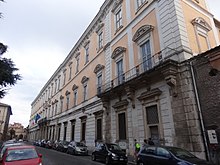Accademia Nazionale dei Lincei
| Accademia Nazionale dei Lincei | |
|---|---|
| motto | Sagacius ista |
| founding | 17th August 1603 |
| Sponsorship | public (duck pubblico) |
| place | Rome , Italy |
| president | Giorgio Parisi |
| Website | www.lincei.it |

The Accademia Nazionale dei Lincei or Accademia dei Lincei for short (in German "Academy of the lynx", lynx-like in the sense of sharp-sighted, original Latin name Academia Lynceorum from Latin lynx "lynx") was the first private institution to promote the natural sciences in Europe. It was founded in Rome in 1603 by the nobleman Federico Cesi and his friends Anastasio de Fillis , Francesco Stelluti and Johannes van Heeck . Its symbol was the lynx , the motto “Sagacius ista”. Today it is the National Academy of Sciences in Italy .
Since 1883 the seat of the Academy has been in the Palazzo Corsini in Via della Lungara in Trastevere . The Villa Farnesina opposite , which had been acquired by the fascist government as the seat of the Accademia d'Italia , passed into the possession of the re-established Accademia dei Lincei after its dissolution, which was forcibly merged with it in 1939.
history
The most famous member was Galileo Galilei , who became a member in April 1611. Also members were Giambattista della Porta , a polymath and playwright, Cardinal Francesco Barberini , a nephew of the later Urban VIII (Pope from 1623 to 1644), and his secretary Cassiano Dal Pozzo .
With the death of its founder in 1630, it lost its importance. After eventful fortunes, it was first in the 19th century by Pope Gregory XVI. closed. In 1847 Pope Pius IX founded the Pontificia Accademia dei Nuovi Lincei . This academy of science split in 1870 with the conquest of the Papal States by Italy: the Italian academy was named Reale Accademia dei Lincei (abbreviation: R. Accademia dei Lincei ), the papal academy was later named Pontificia Accademia Romana dei Nuovi Lincei .
Since the members were mostly reserved towards fascism, Benito Mussolini established the Accademia d'Italia in 1926 , with which the Accademia dei Lincei was merged in 1939. Benedetto Croce's proposal in August 1943 to rebuild the old academy after the collapse of the fascist regime could only be implemented in 1944: it still exists today under the name Accademia Nazionale dei Lincei . It continues the traditions and history of the academy founded in 1603.
Members
According to the 1986 statute, the Academy has 180 full Italian and 180 foreign members and 180 Italian correspondents. They are in two classes ( Classe di Scienze Fisiche, Matematiche e Naturali and Classe di Scienze Morali, Storiche e Filologiche ) with different categories (e.g. Matematica, Meccanica e Applicazioni or Archeologia ) and sections (as examples Matematica , Meccanica e applicazioni della Matematica or Botanica e applicazioni , only in the science class).
Former and current members of the Accademia dei Lincei recorded in the German-language Wikipedia are in the Member of the Accademia dei Lincei category .
literature
- Stillman Drake : The Accademia dei Lincei . In: Science No. 151 of March 11, 1966, pp. 1194 ff.
- David Freedberg : The Eye of the Lynx. Galileo, his friends and the beginning of modern natural history . Chicago, London 2002.
- E. Schettini Piazza: The first Accademia dei Lincei (1603–1630) . In: Baroque in the Vatican. Bonn 2006, pp. 460-461.
- Gabriele Turi: The academies in fascist Italy. A gradual capture. In: Wolfram Fischer (ed.): The Prussian Academy of Sciences in Berlin 1914–1945 , Akademie Verlag, Berlin 2000, ISSN 0949-7285 .
Web links
- Official website
- Pages from the 2003 Four Centenary of the «Comitato Nazionale per le celebrazioni del IV centenario della fondazione dell'Accademia dei Lincei»
- Annuario elettronico 2011 (PDF; 1.99 MB), contains the names of all deceased and living members since 1870, including those who were already members that year, as well as presidents and vice-presidents since 1871 and the chancellor since 1920.
- Monumenti antichi (digitized version of Heidelberg University Library)
Individual evidence
- ↑ https://www.lincei.it/it/organi
- ↑ History of the Academy ( Memento of the original from January 9, 2014 in the Internet Archive ) Info: The archive link was automatically inserted and not yet checked. Please check the original and archive link according to the instructions and then remove this notice. on their website (Italian); Federico Cesi, founder of the "Accademia dei Lincei" (the "lynx-eyed"). In: Rudolf Krämer-Badoni: Galileo Galilei. Munich 1983, p. 75.
- ↑ Palazzo Corsini on the Academy website.
- ↑ Villa Farnesina on the Academy website.